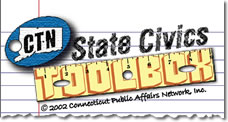
|

A
Short
Simulation
Game
GENERAL
RULES
Developed
by:
Victor
W.
Geraci,
Ph. D. |

|
Click here for the
Word Document version of this
page.
Objective:
Gather as large of
campaign fund war
chest as possible
and use the money
for advertising
plans that will
provide the maximum
exposure to the
state’s voters. Win
the largest amount
of votes and thus
win the election…
The theme of the
game revolves around
the dilemma that
candidates who spend
more on advising and
consultants have a
higher voter
recognition rate and
thus usually get
more votes.
Candidates:
Your goal is to
convince individual
voters, voting
blocks, and PACs to
write you a check
for the maximum
amount that they
have to spend. Once
they give you their
check you may spend
it in the following
categories…
- Television
Commercials ---
Cost $2,500 to
produce, $400 per
commercial
- Radio
Commercials ---
Cost $500 to
produce, $300 per
commercial
- Newspaper
Advertising ---
$2,500 per ˝ page
- Billboard
Advertising ---
$5,000 per
billboard
- Flyers/bumper
stickers ---
$4,000 per
thousand items
- Yard Signs ---
$2,500 per
thousand
Candidate
Roles word |
pdf
Voters:
You goal is to
support the
candidate for United
States Senate that
will best represent
your ideas. Your
support will be a
check written to the
candidate.
Voter Roles
word |
pdf
Play:
-
Introduction
(10-15 minutes)
The teacher will
assign each
student a role and
give him or her
the appropriate
handout. Students,
in turn, will read
their role handout
and act according
to the guidelines
established by
their role. After
reading the role
sheet students
will write out a
list of possible
questions you
would like to ask
the candidate.
Teacher may have
students design
their own roles as
individuals to
suit the needs of
their local
community. Be sure
to view the
extended list of
possible roles.
- Round 1
(10-15 minutes)
Each candidate
will meet with
interest groups
and PAC
representatives to
answer their
questions. Each
candidate’s
campaign manager
will meet with
individual
citizens and
answer their
questions.
- Round 2
(10-15 minutes)
Each candidate and
his/her campaign
manager will meet
on a need be basis
with interest
groups and
individuals.
- Round 3
(5-10 minutes)
Each interest
group or
individual fills
in their check and
gives it to the
candidate they
support.
Candidates then
tally their
revenues.
- Teacher
declares the
Winner –
Candidate with the
most money wins.
Optional: have the
candidates, along
with their
supporters; decide
how they would
allocate their
funds according to
the categories
above.
Debrief:
(10 – 20 minutes) Is
this a good system
for selecting
representatives? Do
all people get
fairly represented?
How can individuals
insure their voice
is heard next to
large contributors?
Has this always been
a problem for
America? What have
we tried to do to
rectify this
campaign finance
dilemma? Should we
continue to do this
in the future? How
has the State of
Connecticut
addressed this
issue?
If you have any
comments or
suggestions about
this activity or
would like to submit
your own activity,
please
contact us
and share your
ideas.
|

